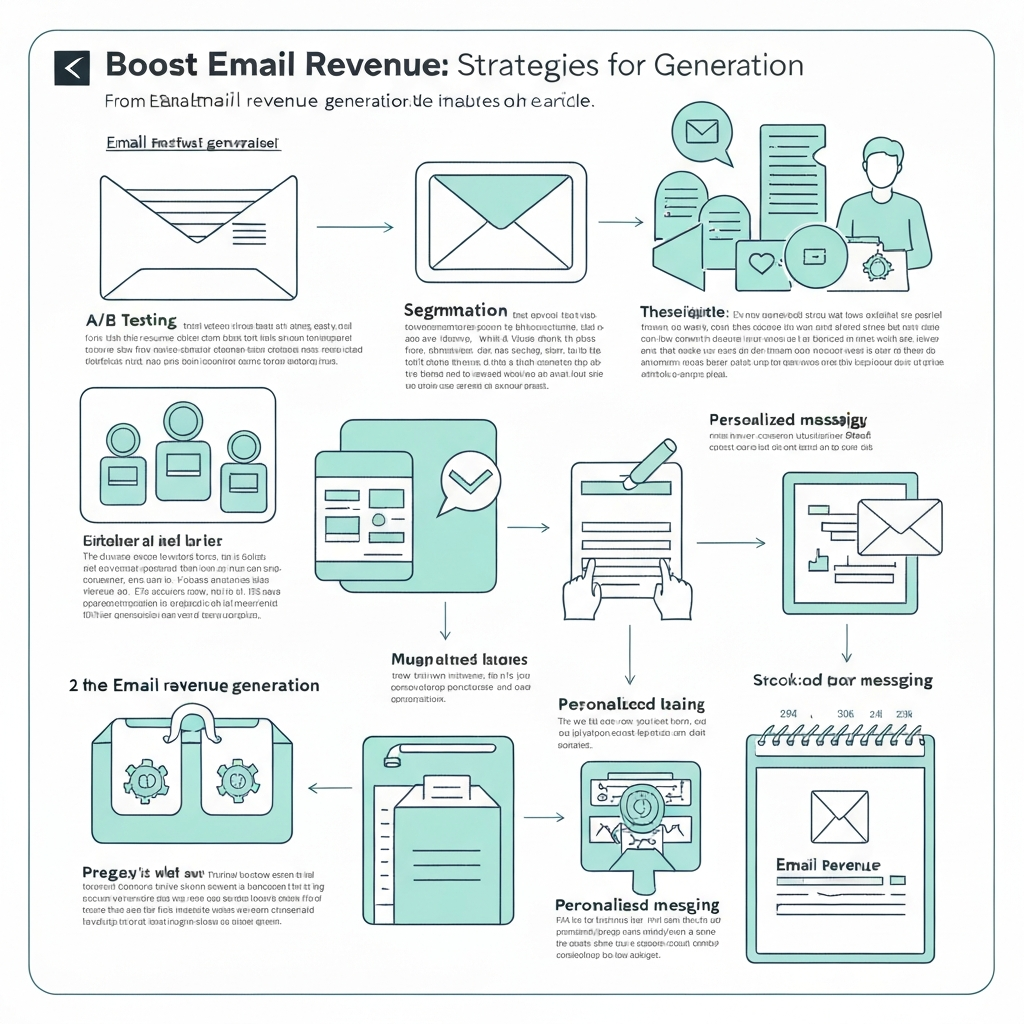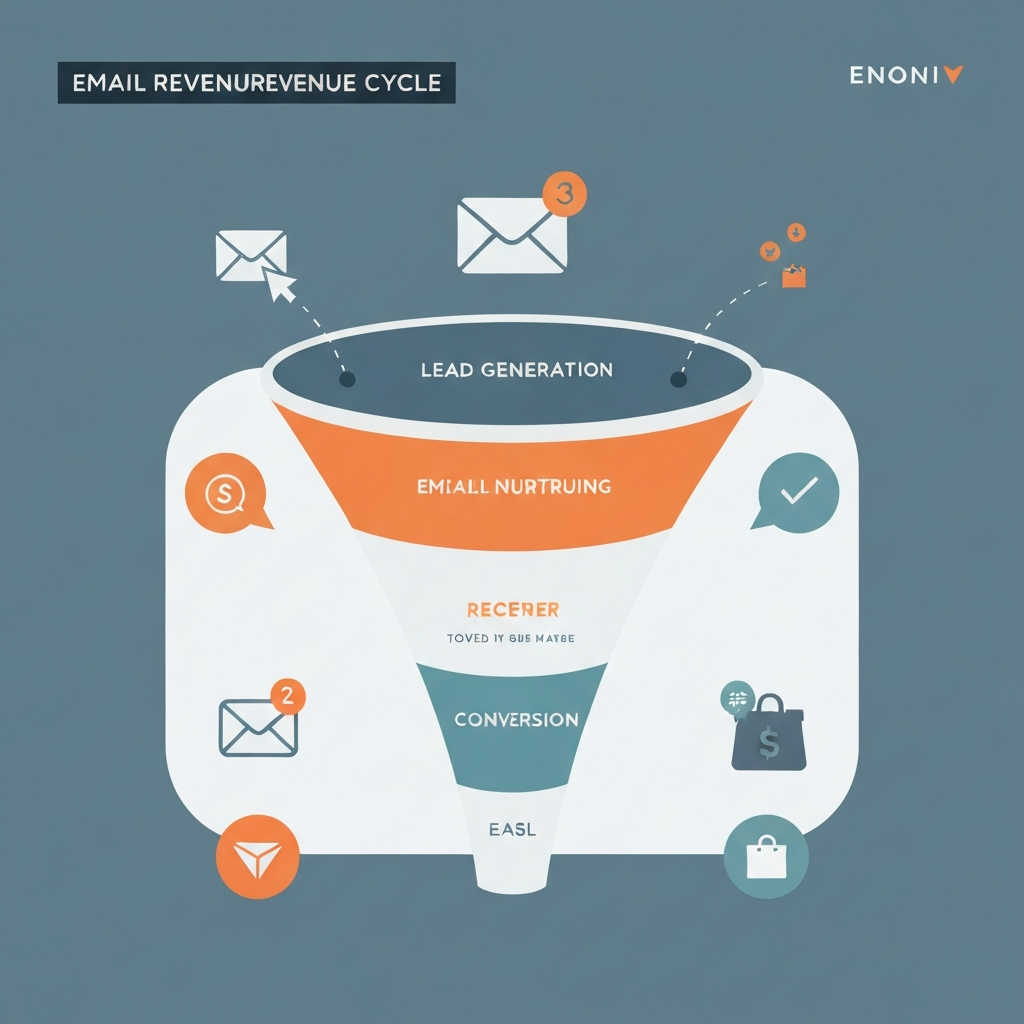Boost Email Revenue: Strategies for Generation

Email. It's the oldest digital marketing channel, yet for many businesses, it remains an underutilized goldmine. We send emails daily – for communication, for updates, for customer service. But are we truly leveraging its immense power for email revenue generation? In today's competitive landscape, simply sending emails isn't enough. To thrive, you need a strategic, data-driven approach that transforms your inbox from a communication tool into a potent sales engine. This guide is designed for business professionals, entrepreneurs, and marketing teams who are ready to unlock the full potential of their email lists and drive tangible business growth. We'll move beyond basic list management and delve into the sophisticated strategies, including powerful AI enhancements, that can dramatically boost your email marketing ROI and increase sales via email.
Understanding Your Audience: Segmentation for Targeted Revenue
Why do generic emails often fall flat? Because they speak to no one in particular. The cornerstone of effective email revenue generation is understanding your audience at a granular level. This is where segmentation comes in. By dividing your subscriber list into smaller, more specific groups based on shared characteristics or behaviors, you can deliver highly relevant, personalized messages that resonate, leading to increased engagement and conversions.
Key Segmentation Strategies
- Demographic Segmentation: Grouping subscribers by age, gender, location, job title, or income level. For example, a clothing retailer might send different promotions to men and women, or tailor offers to specific geographical regions based on climate.
- Behavioral Segmentation: This is incredibly powerful and directly impacts your ability to increase sales via email. It involves segmenting based on how users interact with your brand and emails. This includes:
- Purchase History: Segmenting customers who have bought specific products, high-value items, or are repeat buyers.
- Website Activity: Users who visited specific product pages, added items to their cart but didn't buy, or downloaded a lead magnet.
- Email Engagement: Subscribers who frequently open and click your emails versus those who are less engaged.
- Psychographic Segmentation: Understanding subscribers' interests, values, lifestyles, and opinions. This allows for more lifestyle-oriented content and offers that build deeper connections.
- Lifecycle Stage Segmentation: Targeting users based on where they are in the customer journey – new subscribers, active customers, lapsed customers, etc. This ensures your communication is always relevant to their current needs.
Actionable Advice for Segmentation:
- Start Simple: Don't try to segment every possible way at once. Begin with purchase history and engagement levels, which often yield the quickest results.
- Utilize Your CRM/Email Platform: Most modern platforms offer robust segmentation tools. Invest time in learning how to use them effectively to unlock their full potential.
- Create Buyer Personas: Develop detailed profiles of your ideal customers. This helps you visualize who you're talking to and tailor your messaging accordingly.
- Test and Refine: Continuously analyze which segments perform best and adjust your strategy. What works for one segment might not work for another.
By segmenting your audience, you move from broadcasting to conversing. This targeted approach significantly improves engagement rates, reduces unsubscribes, and directly contributes to a higher email marketing ROI, as you're delivering the right message to the right person at the right time.
Crafting High-Converting Email Campaigns: Content and Design
Once you know who you're talking to, you need to know what to say and how to say it. Crafting effective email campaigns is an art and a science, blending compelling copy with strategic design to drive action and ultimately, increase sales via email. Every element, from the subject line to the call to action, plays a crucial role in guiding the subscriber towards conversion.
The Anatomy of a High-Converting Email:
- Compelling Subject Lines: This is your first impression and dictates whether your email gets opened. It needs to be concise, intriguing, and relevant to the recipient.
- Personalization: Using the subscriber's name or referencing past behavior (e.g., "John, your cart misses you!").
- Urgency/Scarcity: Phrases like "Limited time offer," "Only 3 left," or "Expires tonight" can drive immediate action.
- Curiosity: Posing a question or hinting at exclusive content without giving it all away.
- Benefit-Oriented: Clearly stating what the subscriber will gain (e.g., "Save 20% on your next order").
- Engaging Body Content:
- Value Proposition: Clearly state the benefit of your offer. Why should they care? What problem are you solving?
- Storytelling: Connect emotionally with your audience. Share customer success stories, behind-the-scenes glimpses, or the brand's journey.
- Clear and Concise Language: Avoid jargon and industry buzzwords. Get straight to the point and use language your audience understands.
- Personalization Beyond the Name: Reference past purchases, browsing history, or stated preferences to make the email feel truly bespoke.
- Incentives: As noted by Campaign Monitor, "Giving your subscribers something to gain is a great way to make your email marketing more effective." This can include discounts, freebies, early access, exclusive content, or loyalty points.
- Call to Action (CTA): This is critical. It must be clear, prominent, and action-oriented. Use strong verbs like "Shop Now," "Download Your Guide," "Learn More," or "Claim Your Discount." Ensure there's usually one primary CTA per email to avoid confusion.
- Strategic Design:
- Mobile-First Approach: A significant portion of emails are opened on mobile devices. Your emails must look great and function perfectly on smaller screens. PGM Solutions highlights that "Email has the potential to be a top revenue generator... Optimize for Mobile..."
- Brand Consistency: Use your brand's colors, fonts, and logo to reinforce recognition and build trust.
- Readability: Use sufficient white space, readable fonts, and break up text with headings, bullet points, and images to make scanning easy.
- Visual Appeal: High-quality images or GIFs can enhance engagement and showcase products effectively, but don't let them slow down loading times.
For businesses running regular communications, optimizing revenue from newsletters is a key goal. This involves consistently providing value, whether through educational content, curated news, or exclusive insights, while subtly guiding readers towards conversion points. By mastering these elements, you transform a simple email into a powerful sales tool.
Leveraging AI for Smarter Email Revenue Generation
The evolution of email marketing has been supercharged by Artificial Intelligence. AI isn't just a buzzword; it's a powerful tool that can unlock unprecedented levels of personalization, efficiency, and email revenue generation. By analyzing vast amounts of data, AI can help you make smarter decisions, optimize campaigns, and automate complex tasks, leading to a significant boost in your email marketing ROI.
How AI Enhances Email Revenue:
- Hyper-Personalization at Scale: AI algorithms can analyze individual subscriber data (browsing history, past purchases, engagement patterns) to predict preferences and tailor content, product recommendations, and offers with a level of detail impossible for human marketers alone. This moves beyond simple name insertion to truly individualized experiences that drive conversions.
- Predictive Analytics: AI can forecast trends, predict which subscribers are most likely to convert, and identify those at risk of churning. This allows you to proactively send targeted campaigns to win back at-risk customers or nurture high-potential leads, optimizing your efforts for maximum impact.
- Content Optimization: AI tools can help generate subject line variations, body copy, and even suggest optimal send times for individual subscribers based on their past behavior. This iterative optimization process ensures your emails are always performing at their peak, improving email campaign optimization.
- Automated A/B Testing: AI can run and analyze A/B tests much faster and more comprehensively than manual methods, continuously refining campaign elements for maximum impact and learning what truly resonates with your audience.
- Enhanced Segmentation: AI can identify subtle patterns and correlations in your data that might be missed by traditional segmentation methods, creating even more precise audience segments for highly targeted campaigns.
Exploring the best ai tools available can dramatically transform your email strategy. From AI-powered copywriting assistants to sophisticated analytics platforms, these tools can handle complex data analysis and repetitive tasks, freeing up your team to focus on strategy and creativity. For instance, an ai executive assistant can help streamline your workflow by managing email communications, scheduling follow-ups, and even drafting responses, ensuring that no lead or customer interaction falls through the cracks. Tools like an ai executive assistant can help streamline your workflow, making email management more efficient and allowing you to focus on high-level revenue-generating activities.
By integrating AI, you're not just sending emails; you're orchestrating intelligent, personalized communication journeys that are far more effective at driving conversions and boosting email revenue generation.
Automating Your Way to More Sales: Workflow Strategies
Automation is the engine that powers consistent email revenue generation. It allows you to nurture leads, engage customers, and drive sales 24/7, without manual intervention for every single interaction. Implementing sophisticated automatic email workflows can significantly increase efficiency and directly increase sales via email. This is where AI often plays a supporting role, powering smarter automation and making these workflows more dynamic and effective.
Key Automated Workflows for Revenue Growth:
- Welcome Series: Greet new subscribers warmly, introduce your brand, set expectations, and offer an initial incentive. A well-crafted welcome series can significantly improve long-term engagement and conversion rates, setting the stage for future purchases.
- Example Sequence: Day 1: Welcome & brand intro. Day 3: Highlight key benefits/products. Day 5: Social proof/testimonial. Day 7: Exclusive offer or clear call to action.
- Abandoned Cart Recovery: For e-commerce businesses, this is a goldmine. Send automated reminders to users who added items to their cart but left without purchasing. Often, a gentle nudge or a small discount can seal the deal, recovering lost sales.
- Post-Purchase Follow-ups:
- Order Confirmation & Shipping Updates: Essential for customer service, but can also include cross-sell or upsell opportunities related to their purchase.
- Product Usage Tips/Guides: Help customers get the most out of their purchase, increasing satisfaction and loyalty, which can lead to repeat business.
- Review Requests: Encourage customers to leave feedback, which serves as valuable social proof for future prospects.
- Re-engagement Campaigns: Target inactive subscribers with special offers or compelling content to win them back. If they remain unresponsive after a series of attempts, it might be time to prune them from your list to maintain a healthy sender reputation and improve your email marketing ROI.
- Lead Nurturing Sequences: For B2B or high-value B2C products, automate a series of emails designed to educate prospects, build trust, and guide them towards a sales conversation or purchase. This is crucial for effective email lead generation.
Actionable Advice for Automation:
- Map Your Customer Journey: Understand the typical touchpoints and potential drop-off points for your customers to identify where automation can best intervene.
- Prioritize High-Impact Workflows: Start with welcome series and abandoned cart recovery, as they often offer the quickest wins for revenue generation.
- Segment Your Automated Emails: Even within an automated workflow, personalize based on the user's specific actions or profile to ensure maximum relevance.
- Test and Optimize: Regularly review the performance of your automated workflows and make adjustments to copy, timing, and offers based on data.
Automation ensures that every subscriber receives timely, relevant communication, maximizing opportunities for conversion and fostering stronger customer relationships, all contributing to sustainable email revenue generation.
Measuring Success: Key Metrics for Email Revenue Growth
You can implement the best strategies, but without measurement, you're flying blind. To truly optimize for email revenue generation, you need to track the right metrics. While open rates and click-through rates (CTR) are important indicators, they don't always tell the whole story about revenue impact. Focusing on revenue-centric metrics is key to understanding your true email marketing ROI.
Key Metrics for Tracking Email Revenue:
- Conversion Rate: The percentage of recipients who complete a desired action (e.g., make a purchase, fill out a form, download an asset) after clicking a link in your email. This is a direct indicator of campaign effectiveness and your ability to increase sales via email.
- Revenue Per Email (RPE): This metric directly links email campaigns to sales. It's calculated by dividing the total revenue generated by an email campaign by the number of emails sent. A higher RPE signifies more profitable campaigns.
- Formula: Total Revenue / Emails Sent
- Email Marketing ROI: The ultimate measure of profitability. It compares the revenue generated from email marketing to the cost of implementing it. As Maropost reports, "an average of $42 can be gotten off every dollar spent on email marketing," highlighting its incredible potential when done right.
- Formula: (Revenue from Email Marketing - Cost of Email Marketing) / Cost of Email Marketing * 100
- Customer Lifetime Value (CLV): While not solely an email metric, email marketing plays a significant role in increasing CLV by fostering loyalty, encouraging repeat purchases, and reducing churn.
- List Growth Rate: The speed at which your email list is growing. A healthy growth rate is essential for sustained email lead generation and future revenue potential.
- Unsubscribe Rate & Bounce Rate: High rates here can signal issues with content relevance, sending frequency, or list quality. Regularly cleaning your list with a best email cleaner is crucial to combat high bounce rates, maintain deliverability, and improve overall engagement metrics.
Actionable Advice for Measurement:
- Set Clear Goals: Before launching a campaign, define what success looks like (e.g., achieve a 5% conversion rate, generate $10,000 in revenue).
- Use UTM Parameters: Tag your email links with UTM parameters to accurately track traffic and conversions originating from specific email campaigns in your analytics platform.
- Integrate with Your E-commerce/CRM Platform: Ensure your email marketing platform is connected to your sales data to accurately attribute revenue and understand campaign performance.
- Regularly Review Performance: Dedicate time weekly or monthly to analyze your key metrics and identify trends, successes, and areas for improvement in your email campaign optimization.
- Segment Your Analysis: Look at metrics by segment to understand which groups are most responsive and profitable, allowing for more refined targeting.
By focusing on these revenue-centric metrics, you can demonstrate the true value of your email marketing efforts and make data-backed decisions to continuously improve email campaign optimization and drive more sales.
Common Pitfalls to Avoid in Email Revenue Generation
Even with the best intentions, businesses can stumble on common pitfalls that hinder their email revenue generation efforts. Recognizing these traps is the first step to avoiding them and ensuring your email strategy is effective and profitable.
- Poor List Quality: Sending emails to unengaged, invalid, or purchased lists is a recipe for disaster. This leads to low engagement, high bounce rates, spam complaints, and can damage your sender reputation, impacting deliverability for all your emails.
- Solution: Focus on organic list growth and regular list hygiene using tools like a best email cleaner.
- Generic, One-Size-Fits-All Messaging: Failing to segment and personalize means your emails won't resonate with individual subscribers. This leads to low conversion rates and wasted marketing spend.
- Solution: Implement robust segmentation and personalization strategies as discussed earlier.
- Lack of Clear Calls to Action (CTAs): If subscribers don't know what you want them to do next, they won't do it. Vague or buried CTAs kill conversion rates.
- Solution: Make CTAs prominent, clear, and action-oriented.
- Ignoring Mobile Optimization: With the majority of emails opened on mobile, a poorly designed mobile experience will lead to lost opportunities. PGM Solutions emphasizes the importance of mobile optimization for email success.
- Solution: Always design and test emails for mobile devices first.
- Not Tracking or Analyzing Results: Without understanding what's working and what isn't, you can't improve. This leads to stagnation and missed opportunities for email campaign optimization.
- Solution: Implement robust tracking and schedule regular performance reviews.
- Over-Sending or Under-Sending: Sending too many emails can overwhelm subscribers and lead to unsubscribes. Sending too few can mean you miss opportunities to engage and sell.
- Solution: Test different frequencies and monitor engagement metrics closely.
- Lack of Value: If your emails are purely promotional and offer no educational, entertaining, or exclusive content, subscribers will eventually tune out.
- Solution: Balance promotional content with valuable, engaging material that educates or entertains.
Avoiding these common pitfalls will help ensure your email marketing ROI remains healthy and that your efforts are consistently driving increase sales via email.
Conclusion: Implementing a Sustainable Email Revenue Strategy
Email marketing, when approached strategically, is one of the most powerful and cost-effective channels for email revenue generation. From understanding your audience through meticulous segmentation to crafting compelling, personalized campaigns, every step plays a vital role. The integration of AI and automation further amplifies these efforts, enabling hyper-personalization at scale, efficient workflows, and deeper insights into subscriber behavior, making your efforts more intelligent and impactful.
By focusing on key metrics beyond just opens and clicks, such as conversion rates and revenue per email, you can accurately measure your email marketing ROI and continuously refine your email campaign optimization. Remember to avoid common pitfalls like poor list quality and generic messaging, and always prioritize delivering genuine value to your subscribers. This commitment to value is what fuels long-term engagement and fosters successful email list monetization.
The journey to maximizing revenue from newsletters, driving effective email lead generation, and ultimately achieving significant increase sales via email is ongoing. It requires continuous learning, testing, and adaptation. By implementing the strategies outlined in this guide, you're well on your way to transforming your email list into a predictable and powerful revenue-generating asset for your business. Start refining your approach today, and watch your business grow.



